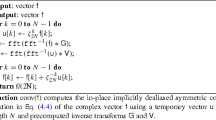Abstract
In this paper, we propose a new approach for computing multidimensional Cooley-Tukey FFT's that is suitable for implementation on a variety of multiprocessor architectures. Our algorithm is derived in this paper from a Cooley decimation-in-time algorithm by using an appropriate indexing process and the tensor product properties. It is proved that the number of multiplications necessary to compute our proposed algorithm is significantly reduced while the number of additions remains almost identical to that of conventional Multidimensional FFT's (MFFT). Comparison results show the powerful performance of the proposed MFFT algorithm against the row-column FFT transform when data dimension M is large. Furthermore, this algorithm, presented in a simple matrix form, will be much easier to implement in practice. Connections of the proposed approach with well-known DFT algorithms are included in this paper and many variations of the proposed algorithm are also pointed out.
Similar content being viewed by others
References
Y. Kung, VLSI and Modern Signal Processing, Englewood Cliffs, NJ: Prentice-Hall, 1985.
W. Cooley and J.W. Tukey, “An Algorithm for the Machine Calculation of Complex Fourier Series,” Math. Comput., vol. 19, no. 90, 1965, pp. 297–301.
H. V. Sorensen and C. S. Burrus, “Efficient Computation of the DFT with only a Subset of Input/Output Points,” IEEE Trans. on Sig. Proc., vol. 41, no. 3, Mar. 1993, pp. 1184–1200.
G. D. Bergland, “A Radix-Eight Fast Fourier Transform Subroutine for Real-Valued Series,” IEEE Trans. Audio Electoacoust., vol. AU-17, no. 2, June 1969, pp. 138–144.
R. C. Singleton, “An Algorithm for Computing the Mixed Radix Fast Fourier Transform,” IEEE Trans. Audio Electoacoust., vol. AU-17, no. 2, June 1969, pp. 93–103.
D. P. Kolba and T.W. Parks, “A Prime Factor FFT Algorithm Using High-Speed Convolution,” IEEE Trans. Acoust., Speech, Signal Processing, vol. ASSP-25, no. 4, Aug. 1977, pp. 281–294.
S. Winograd, “On Computing the Discrete Fourier Transform,” Math. Comput., vol. 32, no. 141, Jan. 1978, pp. 175–199.
H. V. Sorensen, M. T. Heideman, and C. S. Burrus, “On Computing the Split-Radix FFT,” IEEE Trans. Acoust., Speech, Signal Processing, vol. ASSP-34, no. 11, Feb. 1986, pp. 152–156.
W. S. Hinshaw et al., “An Introduction to NMR Imaging: From the Block Equation to the Imaging Equation,” Proc. IEEE, vol. 71, no. 3, Mar. 1983.
I. Gertner and Shamash, “VLSI Architectures for Multidimensional Fourier Transform Processing,” IEEE Trans. on Computers, vol. C-36, no. 11, Nov. 1987, pp. 1265–1274.
G. Angelopoulos and I. Pitas, “Two-Dimensional FFT Algorithms on Hypercube Machines,” Proc. Transputer Applications 91, Glasgow, 1991.
E. O. Brigham, The Fast Fourier Transform and its Applications, Englewood Cliffs, NJ: Prentice-Hall, 1988.
E. Bidet, D. Castelain, C. Joanblanq and P. Senn, “A Fast Single Chip Implementation of 8192 Complex Point FFT,” IEEE Journal of Slid-State Circuits, vol. 30, no. 3, Mar. 1995.
D. Sundararajan, M. Omair Ahmed, and M. N. S. Swamy, “A Fast FFT Bit-Reversal Algorithm,” IEEE Trans. On Circuits and Systems-II: Analog and Digital Sig. Proc., vol. 41, no. 10, Oct. 1994, pp. 701–703.
J. Granata, M. Conner and R. Tolimieri, “The Tensor Product: A Mathematical Programming Language for FFT's and Other Fast DSP Operations,” IEEE SP Magazine, Jan. 1992, pp. 40–48.
E. L. Zapata, F. F. Rivera, I. Benavides, J. M. Carazo and R. Peskin, “Multidimensional Fast Fourier Transform into SIMD Hypercubes,” IEEE Proc., vol. 137, Pt.E, No. 4, July 1990, pp. 257–260.
L. P. W. Niemel and R. Prasad, “On the Reduction of Multidimensional DFT to Separable DFT by Smith Normal Form Theorem,” European Trans. on Telecomm. and Related Techn., vol. 5, no. 3, May- June 1994, pp. 377.
D. E. Dudgeon and R. M. Mersereau, Multidimensional Digital Signal Processing, Englewood Cliffs, NJ: Prentice-Hall, 1984.
Y. A. Geadah and M. J. G. Corinthios, “Natural, Dyadic, and Sequency Order Algorithms and Processors for theWalsh-Hadamard Transform,” IEEE Trans. on Computers, vol. C-26, no. 5, May 1977, pp. 435–442.
B. J. Falkawski, “Properties and Ways of Calculation of Multi-Polarity Generalized Walsh Transforms,” IEEE Trans. on Circ. and Sys.-II: Analog and Digital Signal Processing, vol. 41, no. 6, June 1994, pp. 380–391.
J. H. Lodge and M. Fahmy, “K-Cyclic Symmetries in Multidimensional Sampled Signals,” IEEE Trans. on ASSP, vol. 31, no. 4, Aug. 1983, pp. 847–860.
J. M. Ruis and R. De Porrata-Doria, “New FFT Bit-Reversal Algorithm,” IEEE Trans. on Sig. Proc., vol. 43, ISS.4, Apr. 1995, pp. 991–994.
Author information
Authors and Affiliations
Rights and permissions
About this article
Cite this article
Bouguezal, S., Chikouche, D. & Khellaf, A. An Efficient Algorithm for the Computation of the Multidimensional Discrete Fourier Transform. Multidimensional Systems and Signal Processing 10, 275–304 (1999). https://doi.org/10.1023/A:1008469008412
Issue Date:
DOI: https://doi.org/10.1023/A:1008469008412




